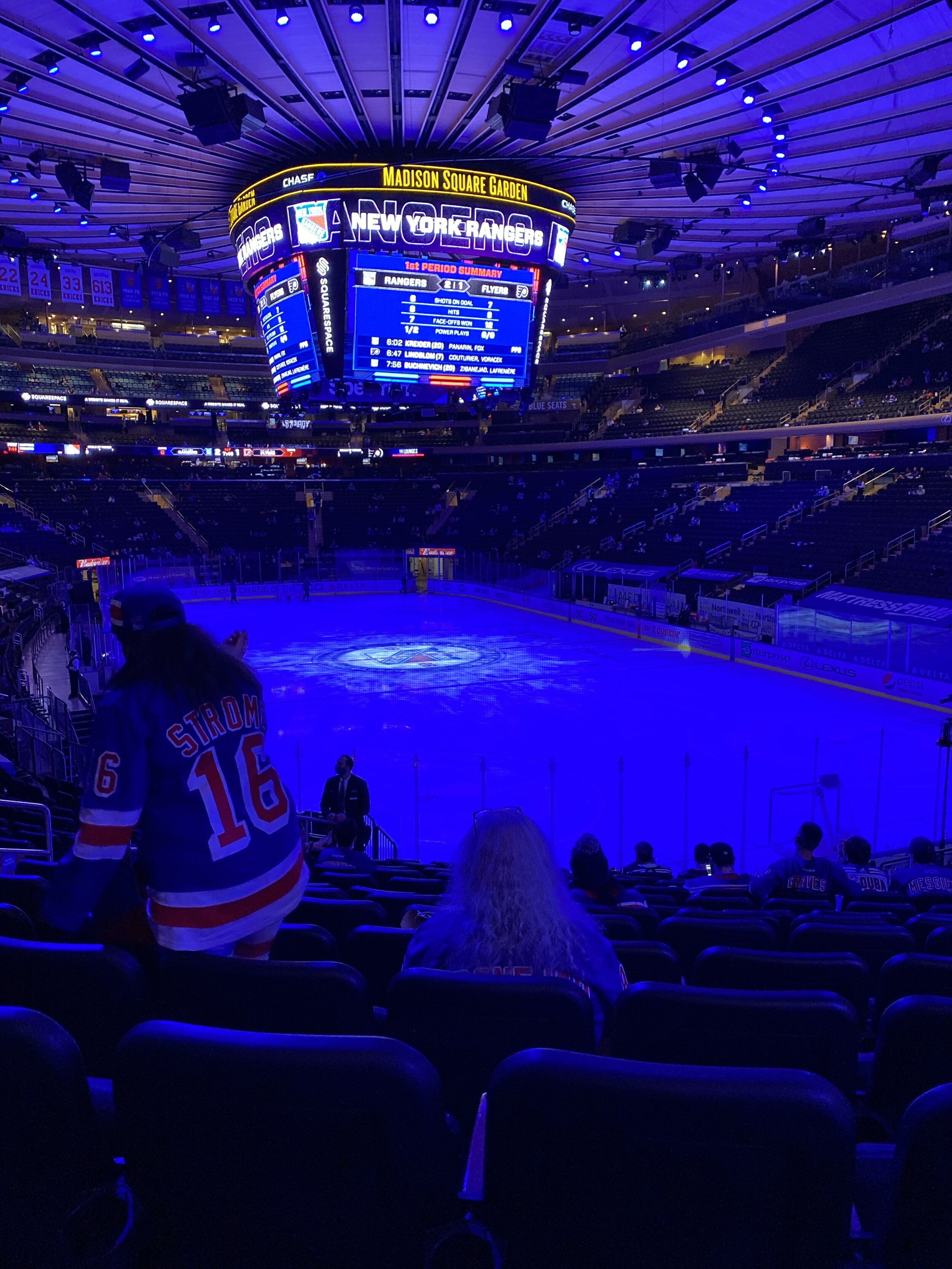Going to a Game During COVID: Better or Worse?
Smaller crowds at in-person sporting events allow for a safe experience, calmer event
On April 23, I attended my first live sporting event since the coronavirus pandemic began. I saw my beloved New York Rangers take down the Philadelphia Flyers from Madison Square Garden in New York City. I was one of roughly 1,900 fans lucky enough to cheer on their team in-person in this new world.
I would love to provide all the details about the game itself – how Rangers goaltender Alexandar Georgiev steered the team to the clear 4-1 victory and how the Rangers continue to refuse to let their playoff dreams die – but that was not the most intriguing part of the game.
Madison Square Garden during a Rangers vs Flyers game. Source: Sam Murphy
The most striking aspect of the game was that there were essentially no fans in the stands, or at least it felt like it. I loved that.
As a fan that has been to many Rangers games at MSG as well as other arenas and stadiums across the country, I am used to large crowds and the bustling atmosphere from the minute I step off the subway one block from The Garden. MSG sits atop Penn Station, the busiest train station in North America, meaning that just commuting to the game requires encountering hockey fans, train travelers and the general pedestrian traffic of Midtown Manhattan.
Once inside the building, I walk to security, have my ticket scanned and head up the escalators to find my seat, among 19,000 other people trying to do the same. Between periods, the hallways would be littered with fans looking for food, drinks and taking a bathroom break. The experience I had this past week was completely different.
Just like the rest of New York City these days, MSG was practically empty without crowds, tourists and taxi lines occupying roadways. Instead of being greeted by requests to buy a hot dogs, I was greeted by the request for proof of full vaccination or a recent negative COVID test. This is a necessary step for large venues to open while keeping spectators safe in this new world.
However, it is in no way an inconvenience. If attending a game at MSG, you can schedule a rapid COVID test for just hours before the game from the arena itself. Those with a complete vaccine series do not need to get a test, and New Yorkers can download the state’s Excelsior Pass to their phone wallet for maximum ease. In addition, you must complete a brief health survey 12 hours prior to entering the venue.
Once I arrived at my seat, the differences became even more unmistakable. I looked around the arena to what looked like one in every ten seats being open. This was a result of the 10% capacity reopening requirement the stadium instituted. There’s an apparent quietness floating around the entire building that only leaves room to reminisce over memories of raucous opening nights at intense playoff battles.
Also, unique to these new times are the ‘Mask Police.’ Arena workers posted across the stands to monitor fans in their seats and ensure they keep their masks on at all times, except when eating.
It’s also hard not to remember why the building is 90% empty: a deadly pandemic took a stranglehold on the world we knew and made mass gatherings like this extremely dangerous. Yet, despite what’s missing, I can’t help but acknowledge the positives from this new experience.
Most evident is the significantly more relaxed feeling throughout the entire arena. There’s finally room to breathe from entering the building, to waiting in line for food, to even scooting past the row to get to my seat.
While the noise of a loud crowd is sorely missed, I could still hear fans cheering. Rangers fans still know to do the traditional “Potvin sucks!” New and one of my favorite aspects of attending a game during COVID-19, is the ability to hear the players talking on the ice. Hearing two NHL defensemen talk to each other as the puck is dumped into their end and the crispness of the pass they make is pure ear candy to a true hockey fan.
Finally, leaving the game is radically different. In my previous experience, when 19,000 people leave one place at the same time, MSG gets crowded and unorganized quickly, worsened by the population of New Yorkers leaving who don’t want to miss their train. My memories of leaving the game involve being trapped between fans on the staircase like a sardine, each step sinking my sneaker deeper into a new puddle of Bud Light. This time, just like the rest of my in-person sporting experience, leaving MSG was orderly and easy.
While I will welcome a return to ‘normal’ post-pandemic life, I am in no way rushing to see arenas packed again. COVID-19 has brought a unique opportunity to experience previous large gatherings without the intense crowds for an intimate view and unique experiences. Plus, it’s not exclusive to sports with concerts and shows doing the same. We should welcome the slower pace COVID-19 has introduced because we can still and enjoy the sights and sounds, far away from others.
